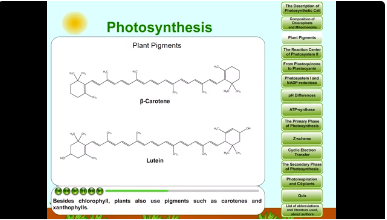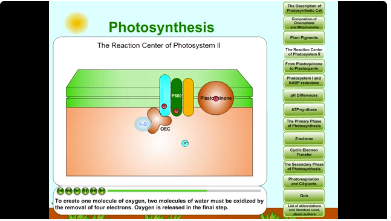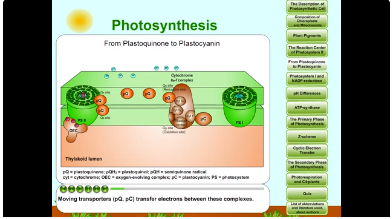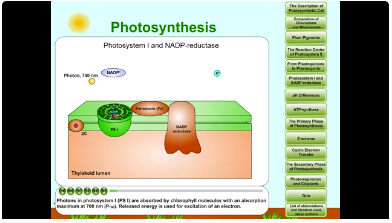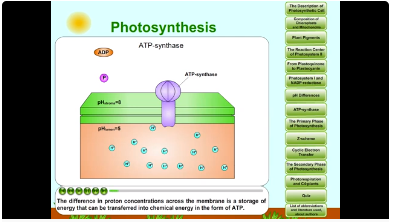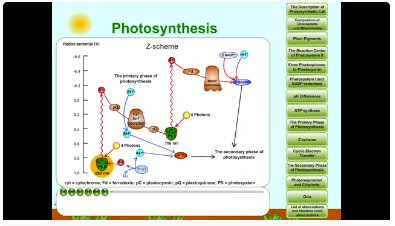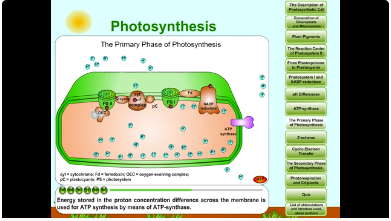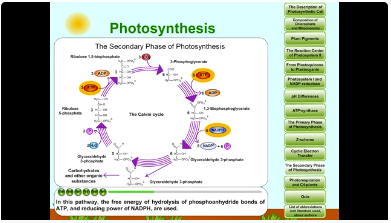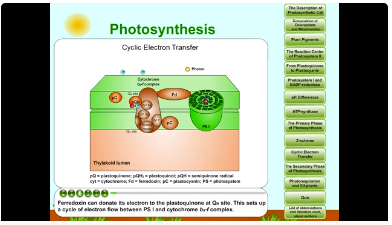Milada Teplá
KUDCH, PřF UK v Praze
email: milada.tepla@natur.cuni.cz
Biochemie - základní kapitoly
Buňka - úvod
Nukleové kyseliny a proteosyntéza
Přírodní látky
Trávení
Metabolismus
- Základní pojmy
- Metabolismus sacharidů
- Metabolismus triacylglycerolů
- Metabolismus bílkovin
- Citrátový cyklus
- Vztahy mezi metabolismy
- Lokalizace pochodů v buňce
- Dýchací řetězec
- Fotosyntéza
- Photosynthesis
- Electron Transport Chain
- Výukové materiály
Další informace
Photosynthesis
Educational materials:
|
The Description of Photosythetic Cell, Composition of Mitochondria: movie / youtube |
|
|
The Secondary Phase of Photosynthesis
- Calvin Cycle: |
|
|
Playlist (youtube): all animations |
Chapters:
1. Introduction
1.1.The Description of Photosythetic Cell
2. The Primary Phase of Photosynthesis
2.1. Plant Pigments
2.2.The Reaction Center of Photosystem II
2.3. From Plastoquinone to Plastocyanin
2.4. ATP-synthase
2.5. The Primary Phase of Photosynthesis – scheme
2.6. Z-scheme
2.7. Cyclic Electron Transfer
3. The Secondary Phase of Photosynthesis
3.1. Calvin Cycle
3.2. Photorespiration and C4-plants
4. Quiz
5. List of Abbreviations
6. Literature
1. Introduction
6 CO2 + 12 H2O → C6H12O6 + 6 O2 + 6 H2O
1.1. The Description of Photosythetic Cell
The entire process of photosynthesis in eukaryotic organisms takes place in the chloroplasts. Inside the chloroplasts are discoidal membrane vesicles called thylakoids, which are interconnected and make up the so-called grana.

Fig. 1: The Description of Photosythetic Cell.
Chloroplasts are complex organelles as mitochondria. They have three types of membranes: the outer membrane, inner membrane and thylakoid membrane. The primary phase of photosynthesis takes place mainly in the thylakoid membrane. The secondary process of photosynthesis takes place in the stroma of the chloroplast.

Fig. 2: Composition of Chloroplasts and Mitochondria.
The Description of Photosythetic Cell, Composition of Mitochondria: movie / https://youtu.be/lP17DVasqHY
2. The Primary Phase of Photosynthesis
2.1. Plant Pigments
Photosynthesis is a process driven by light (photon energy). Chloroplasts contain plant pigments with many conjugated double bonds. These molecules absorb visible light. The main plant pigment is chlorophyll a. Chlorophyll is a chlorin pigment. At the center of the chlorin ring is a magnesium ion. The chlorin ring can have several different side chains, usually including a long phytol chain.
Besides chlorophyll, plants also use pigments such as carotenes and xanthophylls. Carotenes (such as β-carotene) are unsaturated aliphatic hydrocarbon substances with a formula of C40Hx. Xanthophylls (such as lutein) are similar to carotenes. Xanthophylls contain oxygen atoms, whereas carotenes are purely hydrocarbons with no oxygen.


The primary photosynthetic reaction takes place in the photosynthetic reaction centers, which are located in the thylakoid membrane. The reaction center is a part of photosystems I and II and contains a special pair of chlorophyll a molecules. In the reaction center only chlorophyll a can be oxidized, meaning that it can convert the energy of the absorbed photon to chemical energy. The other pigments act as light-harvesting antennae, transmitting the energy of the absorbed photons from one molecule of antennae pigment to another until the absorbed photon energy finally reaches the photosynthetic reaction center, where the oxidation of the chlorophyll a molecule occurs. These light-harvesting pigments (chlorophyll a and b, carotenes and lutein) are part of the light-harvesting complex (LHC).

Fig. 3: Light-harvesting antennae.
Plant Pigments: movie / https://youtu.be/NtuFsDOelHg
2.2. The Reaction Center of Photosystem II
The reaction center of the photosystem is a protein complex that binds a special pair of chlorophyll a molecules. Chlorophyll a in the PS II reaction center is called P680, in accordance with the wavelength of its maximum absorption. After the impact of the photon, an electron is emitted which is then passed onto the acceptor. A positively charged molecule of chlorophyll is derived which is a very strong oxidizing agent. The positively charged chlorophyll molecule immediately takes an electron from the donor and returns to its original state. The electron donor is regenerated by the electron which results from the photolysis of water. The OEC (Oxygen-evolving complex) binds two molecules of water and facilitates the formation of oxygen that gradually takes away electrons and protons. Protons are released into the thylakoid lumen. The electron from the acceptor (pheophytin) is transmitted to the plastoquinone. To create one molecule of oxygen, two molecules of water must be oxidized by the removal of four electrons. Oxygen is released in the final step. Oxygen is released into the atmosphere.

Fig. 4: The Reaction Center of Photosysystem II .
The Reaction Center of Photosystem II: movie / https://youtu.be/HmTqdKvkhYY
2.3. From Plastoquinone to Plastocyanin
Oxygenic photosynthesis takes place in three complexes (cytochrome b6-f complex, PS I and PS II) that permeate the thylakoid membrane. Moving transporters (pQ - plastoquinone, pC - plastocyanin) transfer electrons between these complexes.
Electron is transferred from pheophytin to a plastoquinone molecule (pQ) that is permanently bound to PS II at a QA site. Plastoquinone at the QA site works as one-electron acceptor. The electron is then transferred to another pQ that is loosely bound at the QB site. This pQ works as two-electron acceptor. The full reduction of pQ requires the addition of two electrons and two protons. The pQH2 then unbids from reaction center and diffuses in the hydrophobic core of the membrane. pQH2 binds to the oxidation site (QO site) of cytochrome b6-f complex. Another molecule of an oxidized pQ binds to the QB site of PS II and the process is repeated. pQH2 is oxidized by a cytochrome b6-f complex at QO site. The first electron going to the Rieske iron-sulfur (Fe2S2) center, and the second electron to cytochrome bL. The electron transferred to the Rieske center is transferred to cytochrome f and then to a small protein called plastocyanin (pC). pC shuttles electrons from cytochrome f to PS I. The electron transferred to cytochrome bL is transferred to cytochrome bH and then to another pQ that is bound at a reduction site (QR site). Oxidized pQ unbinds from the complex and is replaced by pQH2. Another molecule of an oxidized pQ binds to the QB site of PS II. pQH2 is oxidized by a cytochrome b6-f complex at QO site. pQH2 is then released from the QR site and binds to the QO site. Another oxidized pQ is bound at a reduction site (QR site). The processes are repeated. Cycling of electrons results in transfer of a two H+ per each electron passing through the cytochrome b6-f complex, from the stroma to lumen. This mechanism is called the "Q-cycle". Protons and electrons are transferred through the oxidation-reduction loop known as the Q-cycle.


Fig. 5: From Plastoquinone to Plastocyanin.
From Plastoquinone to Plastocyanin: movie / https://youtu.be/LWyStoMTGuI
Photons in photosystem I (PS I) are absorbed by chlorophyll molecules with an absorption maximum at 700 nm (P700). Released energy is used for excitation of an electron. The excited electron is transferred from the photosystem I acceptor to ferredoxin (Fd). The oxidized chlorophyll molecule receives an electron from plastocyanin (pC). Plastocyanin takes an electron from cytochrome b6-f complex and returns to reduced state. The electron is transferred from ferredoxin to NADP-reductase, which uses two electrons and a proton to reduce the coenzyme NADP+ to NADPH.
NADP+ + H+ + 2e- → NADPH (nikotinamide adenine dinucleotide phosphate)


Fig. 7: Photosystem I and NADP-redukctase.
Photosystem I and NADP-reductase: movie / https://youtu.be/wIHAE1dAdm0
2.4. ATP-sythase
Electrochemical proton gradient occurs during the photosynthesis. The first process that leads to the proton gradient is photolysis of water (release of protons by the oxidation of water in the oxygen evolving complex). The second process that leads to the proton gradient is binding of H+ by plastoquinone and their release by cytochrome b6-f (for every 1 electron, about 2 protons are transferred). The third process that leads to the proton gradient is consumption of two protons in the reduction of NADP+ to NADPH. These processes produce an electrochemical proton gradient (proton concentration in the lumen is much higher than in the stroma). Higher concentration of protons causes a lower pH.

Fig. 8: The difference in pH.
pH Differences: movie / https://youtu.be/D7hY3k6GF7s
The difference in proton concentrations across the membrane is a storage of energy that can be transferred into chemical energy in the form of ATP. During the transition of protons back into the stroma energy is released that drives the synthesis of ATP from ADP and inorganic phosphate P. This synthesis of ATP is called photophosphorylation. The synthesis of one ATP molecule seems to require the translocation of four protons. ATP is degraded to provide energy for cellular processes like the synthesis of carbohydrates and other cellular structures.

Fig. 9: ATP-synthase.
ATP-synthase: movie / https://youtu.be/zimqmPL-1g4
2.5. The Primary Phase of Photosynthesis – scheme
In plants, photochemical reactions occur in two reaction centers belonging to PS I and PS II, which operate in series. An electron is transferred from the excited PS II, passing through a series of vectors to PS I. The electron from excited PS I is transferred to ferredoxin. NADPH is produced. Energy stored in the proton concentration difference across the membrane is used for ATP synthesis by means of ATP-synthase. PS II contains an oxygen-evolving complex, which oxidizes the 2 H2O to 4 H+ and oxygen, and is released after four electrons are removed. The products (ATP and NADPH) are transferred to the Calvin cycle and oxygen is released into the atmosphere. The primary phase of photosynthesis is often called the "Light Reactions" because light is required to make them happen.

Fig. 10: The Primary Phase of Photosynthesis.
The Primary Phase of Photosynthesis – scheme (= Introduction to the Photosynthesis): movie /https://youtu.be/p1DoIAAL20E
2.6. Z-scheme
PS II creates strong oxidant, capable of oxidizing H2O, and also weak reductant (not capable of reducing NADP+). PS I creates weak oxidant (not capable of oxidizing water), and also strong reductant, which is capable of reducing NADP+. PS I creates weak oxidant (not capable of oxidizing water), and also strong reductant, which is capable of reducing NADP+. In order to carry out the photosynthetic transport of electrons from H2O to NADP+, both photosystems must work together.

Fig. 11: Z-scheme.
Z-scheme: movie / https://youtu.be/5aWFrhUrEBg
2.7. Cyclic Electron Transfer
Ferredoxin can donate its electron to the plastoquinone at QR site. This sets up a cycle of electron flow between PS I and cytochrome b6-f complex. The cyclic flow of electrons can generate ATP through the generation of a proton gradient across the thylakoid membrane. However, NADPH is not generated because electrons are diverted to the cytochrome b6-f complex instead of being used to reduce NADP+.

Fig. 12: Cyclic Electron Transfer.
Cyclic Electron Transfer movie / https://youtu.be/eRT-3FkqrAE
3. The Secondary Phase of Photosynthesis
3.1. The Calvin cycle
The products of the primary phase of photosynthesis (ATP and NADPH molecules) enter the secondary phase of photosynthesis, the Calvin cycle. In this pathway, the free energy of hydrolysis of phosphoanhydride bonds of ATP, and reducing power of NADPH, are used. In the Calvin cycle, inorganic carbon (bound in a molecule of carbon dioxide) changes to organic carbon. The carbon dioxide acceptor is ribulose-1,5-bisphosphate, the enzyme which catalyzes this reaction is called ribulose bisphosphate carboxylase (RuBisCO). During the Calvin cycle glyceraldehyde-3-phosphate is produced and converted to carbohydrates and other organic substances. The secondary phase of photosynthesis is often called the "Dark Reactions" because they can operate in the dark so long as sufficient NADPH and ATP are present.

Fig. 13: The calvin cycle.
The Secondary Phase of Photosynthesis - Calvin Cycle: movie / https://youtu.be/b-B4aRgIaUQ
3.2. Photorespiration and C4-plants
In addition to the mitochondrial respiration, Rubisco can use oxygen instead of CO2 in a reaction that leads to the photorespiration process. Some species of plants accumulate CO2 in photosynthetic cells, thus reducing photorespiration losses. These are called C4-plants. Some of these are tropical plants (such as sugar cane or corn). C4-plants contain two types of cells: mesophyll cells (CO2 fixation) and vascular bundle sheath cells (release of CO2 to the Calvin cycle). Chloroplasts of mesophyll cells lack Rubisco. Instead they hydrate CO2 to bicarbonate and couple it to phosphoenolpyruvate to form oxaloacetate. Oxaloacetate is reduced to malate which is transferred to the vascular bundle sheath cells. Oxaloacetate and malate are four-carbon acids, which is why plants that use this process are called C4-plants. In the vascular bundle sheath cells, malate is cleaved to CO2 and pyruvate. The CO2 enters the Calvin cycle while the pyruvate is returned to the mesophyll cell to complete the cycle. The CO2 concentration mechanism in C4-plants suppresses photorespiration.

Fig. 14: Photorespiration and C4-plants.
Photorespiration and C4-plants: movie / https://youtu.be/v4TMcYOTQFM
4. Quiz

Fig. 15: Quiz
Quiz: movie / https://youtu.be/0kPrAC_QQ2I
5. List of Abbreviations

6. Literature
-
Alberts, B.; Bray, D.; Hopkin, K.; Johnson, A.; Lewis, N.; Raff, M.; Roberts, K.; Walter, P. Essential Cell Biology: An Introduction to Molecular Biology of the Cell; Garland Publishing, Inc.: New York, 1998; pp 840−855.
-
Raghavendra, A. S. Photosynthesis: A Comprehensive Treatise; Cambridge University Press: United Kingdom, 2000; pp 87−104.
-
Heldt, H. W.; Piechulla, B. Plant Biochemistry, 4th ed.; Elsevier: United States of America, 2011; pp 65−109.
-
Voet, D. J.; Voet, J. G. Biochemistry, 4th ed.; John Wiley & Sons, Inc.: United States of America, 2011; pp 901−939.

